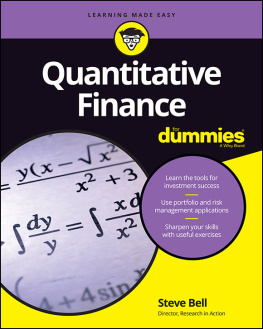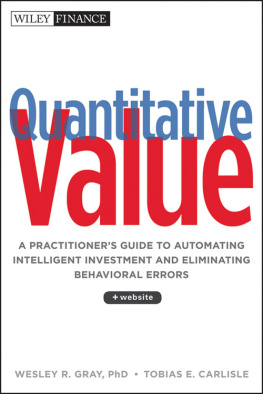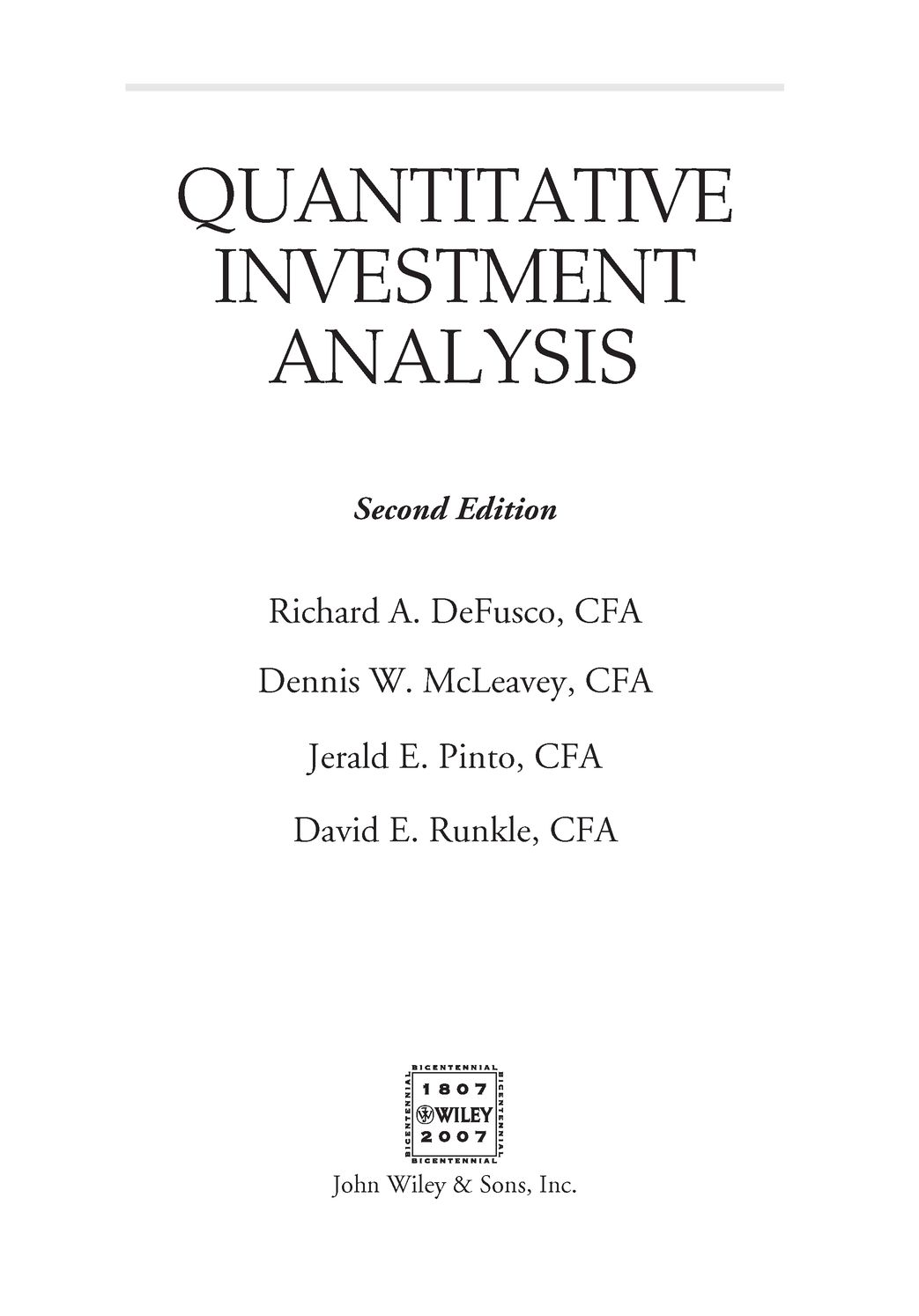Table of Contents
CFA Institute is the premier association for investment professionals around the world, with over 85,000 members in 129 countries. Since 1963 the organization has developed and administered the renowned Chartered Financial Analyst Program. With a rich history of leading the investment profession, CFA Institute has set the highest standards in ethics, education, and professional excellence within the global investment community, and is the foremost authority on investment profession conduct and practice.
Each book in the CFA Institute Investment Series is geared toward industry practitioners along with graduate-level finance students and covers the most important topics in the industry. The authors of these cutting-edge books are themselves industry professionals and academics and bring their wealth of knowledge and expertise to this series.
To Margo, Rachel, and Rebekah
R.A.D.
To Jan, Christine, and Andy
D.W.M.
In memory of Irwin T. Vanderhoof, CFA
J.E.P.
To Patricia, Anne, and Sarah
D.E.R.
FOREWORD
HOW QUANTITATIVE INVESTMENT ANALYSIS CAN IMPROVE PORTFOLIO DECISION MAKING
I am a Quant. By my own self-admission, I use quantitative investment techniques in the management of investment portfolios. However, when I tell people that I am a Quant, they often respond: But Mark, arent you a lawyer? Well, yes, but...
The fact is that Quants come from all walks of life. Whether we are called Quants, Quant Jocks, Gear Heads, Computer Monkeys, or any of the other monikers that are attached to investors who like to scribble equations on a piece of paper, we all share a common denominatorthe use of quantitative analysis to make better investment decisions. You dont have to be a rocket scientist with a Ph.D. in an esoteric mathematical field to be a Quant (although there are, I suspect, several former rocket scientists who have found working in the financial markets to be both fun and profitable). Anyone can become a Quanteven a lawyer.
But lets take a step back. Why should any investor want to use quantitative tools in the management of investment portfolios? There are three reasons why Quants are so popular.
First, the financial markets are very complicated places. There are many interwoven variables that can affect the price of securities in an investment portfolio. For example, the stock price of a public company can be affected by macroeconomic factors such as the level of interest rates, current account deficits, government spending, and economic cycles. These factors may affect the cost of capital at which a corporation finances its new projects, or influence the spending patterns of the companys customers, or provide economic impetus through government spending programs.
In addition to macro variables, the value of a companys stock can be affected by factors that are peculiar to the company itself. Factors such as cash flow, working capital, book-to-market value, earnings growth rates, dividend policy, and debt-to-equity ratios affect the individual value of each public company. These are considered to be the fundamental factors that have an impact on the specific company as opposed to the broader stock market.
Then we come to the financial market variables that affect a companys valuation. Its beta or measure of systematic risk will impact the expected return for the company and, in turn, its stock price. The famous Capital Asset Pricing Model that measures a stocks beta is really just a linear regression equation of the type described in Chapter 8.
Last, there are behavioral variables that can affect security values. Such behavior as herding, overconfidence, overreaction to earnings announcements, and momentum trading can all impact the price of a companys stock. These behavioral variables can have a lasting impact on a stock price (remember the technology bubble of 19982001 when tech stocks were going to take over the world?) as well as generate a significant amount of noise around a securitys true value.
Considering all of these variables together at one time to determine the true value of a security can be an overwhelming task without some framework in which to analyze their impact. It is simply not possible for the human mind alone (at least, not mine) to be able to weigh the impact of individual company specific factors such as price-to-earnings ratios, macroeconomic variables such as government spending programs, investor behavioral patterns such as momentum trading, and other potentially influential variables in a rigorous fashion within the human brain.
This is where Quantitative Investment Analysis can help. Factor modeling techniques such as those described in Chapter 11 can be used to supplement the intuition of the human mind to produce a quantitative framework that digests the large number of plausible variables that can impact the price of a security. Further, given the many variables that can affect a securitys value, it is not possible to consider each variable in isolation. The economic factors that cause a securitys price to go up or down are interwoven in a complex web such that the variables must be considered together to determine their collective impact on the price of a security.
This is where the value of Chapters 8 and 9 are most useful. These two chapters provide the basic knowledge for building regression equations to study the impact of economic factors on security prices. The regression techniques provided in Chapters 8 and 9 can be used to filter out which variables have a significant impact on the price of a security, and which variables just provide noise.
In addition, Chapter 9 introduces the reader to dummy variables. Despite their name, you dont have to be a dummy like me to use them. Dummy variables are a neat way to study different states of the world and their impact on security prices. They are often referred to as binary variables because they divide the world into two states for observation, for example, financial markets up versus financial markets down; Republicans in control of the White House versus Democrats in control of the White House; Chicago Cubs win (almost never) versus Chicago Cubs lose; and so on. This last variablethe record of the Chicago CubsI can attest has no impact on security valuations, although, as a long-standing and suffering Cub fan, it does have an impact on my morale.
As another example, consider a recent research paper where I studied the behavior of private equity managers in the way they price their private equity portfolios depending on whether the public stock markets were doing well versus when the public stock markets were doing poorly. To conduct this analysis, I ran a regression equation using dummy variables to divide the world into two states: up public stock markets versus down public stock markets. By using dummy variables in this manner, I was able to observe different behavioral patterns of private equity managers in how they marked up or down their private equity portfolios depending on the performance of the public stock markets.
The second reason Quantitative Investment Analysis will add value to the reader is that it provides the basic tools to consider a breadth of economic factors and securities. It is not only the fact that there are many interwoven economic variables that impact the value of a security, the sheer number of securities in the market place can be daunting. Therefore, most investors only look at a subset of the investable securities in the market.



![Keith A. Allman [Keith A. Allman] - Impact Investment: A Practical Guide to Investment Process and Social Impact Analysis](/uploads/posts/book/124124/thumbs/keith-a-allman-keith-a-allman-impact.jpg)



